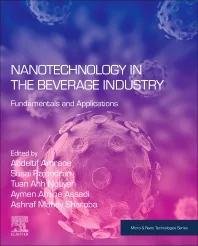Botanicals blossom across beverage categories
Health attributes, flavors prompt consumer interest

Image courtesy of Getty Images
In business, gardening metaphors are often used to describe growth using words such as “planting seeds” that “reap” financial rewards. In a similar vein, when it comes to the growth of the botanicals market, it can be said that the market is “flourishing.”
According to a recent report from Market.us, the global botanicals market was valued around $107 billion in 2022 and is expected to reach approximately $207 billion in 2032 with a compound annual growth rate (CAGR) slightly above 7% between 2023 and 2032.
In its “Global Botanicals Market” report, Market.us highlights how the market is primarily driven by increasingly health-conscious consumers, along with clean trademark trends in the food and beverage industries.
“Consumers are rapidly switching to healthier alternatives, embracing prevention as an essential tool for living a better lifestyle,” the report states. “Therefore, botanical ingredients are a rich source of bioactive compounds and are increasingly used in the production of food and beverages as they exert a wide scope of biological effects.”
Alessio Tagliaferri, global business director for natural health and nutrition and botanicals technology platform at ADM, Chicago, notes that beverages that incorporate botanicals are increasingly capturing shoppers’ attention.
“In fact, consumers tend to associate products that list botanical ingredients with perceived better-for-you characteristics,” he says, citing a 2022 report from FMCG Gurus titled “Non-Alcoholic Beverages, Global Report.” “Today’s consumers are also looking more closely at product ingredient labels, increasing the demand for clean labels and supply chain transparency from beverage brands.
“Given that, recognizable ingredients that consumers perceive as ‘closer-to-nature’ are trending,” Tagliaferri continues. “Botanical ingredients can check this box, as research shows that 71% of consumers are aware of at least one botanical.”
Leslie Gallo, president of Artemis International, Fort Wayne, Ind., points to a growing consumer preference for natural plant-based products, instead of drug-based or synthetic products, as fueling interest in botanicals.
“I think it is safe to say that many consumers are anxious, stressed or tired, and adaptogens can help relieve those conditions naturally with plant-based botanicals and teas.” she says.
Erin O’Donnell, marketing manager for taste at Florida Food Products (FFP), Eustis, Fla., echoes similar sentiments, noting that consumers are concerned with mental health and specific lifestyle needs where botanicals and adaptogens can play a large role.
“Beverage formulators must keep healthy lifestyles at the forefront, but also get creative in using botanicals and adaptogens when developing new beverages to meet a variety of consumer health needs — whether it is increased focus and cognitive function, improved sleep or clean energy,” she explains.
Ingredients that span across categories
As the use of botanicals is rapidly increasing across products in the beverage space, experts highlight the various categories embracing these ingredients.
“Research finds that including botanicals encourages consumers to drink beverages like functional juice/water, carbonated fruit beverages and still soft drinks more frequently,” ADM’s Tagliaferri says. “We also commonly see their inclusion in functional beverage applications like energy drinks, bottled teas and active nutrition shakes because of their perceived wellness attributes.
“For instance, guarana, green coffee and yerba mate contain caffeine, which consumers associate with reducing fatigue and improving mental focus, and they are excellent inclusions in energy drinks and performance beverages,” he continues.
Artemis’ Gallo points to significant growth within ready-to-drink (RTD) beverage categories.
“Teas such as elderberry, echinacea and lavender have always been a popular delivery of herbs, botanicals and adaptogens,” she says. “But we have seen significant growth in RTD shots, juices, probiotic beverages, and more recently, sparkling beverages using botanicals to deliver health benefits.
“Our CherryCraft tart cherry extract is being requested for beverage applications for sports recovery, as well as for energy drinks with added benefits,” Gallo continues. “The beverage market is thirsty for innovative solutions.”
Echoing similar sentiments, FFP’s O’Donnell notes that aside from mocktails, botanicals also work well in a variety of RTD tea beverages, as well as functional drinks such as clean energy beverages.
“But we are also seeing these botanical extracts and adaptogens in RTD coffee, kombucha, juices and smoothies,” she says.
ADM’s Tagliaferri points to categories embracing botanicals not only for health attributes, but also for the intriguing taste experiences these ingredients can provide.
“Botanicals can achieve a delicate balance of flavors, spanning from herbal and earthy to floral and sweet, and even spicy and citrusy, building memorable flavor experiences,” he says. “For instance, the combination of rosemary and thyme make for a delicious lemonade, and the invigorating blend of lemongrass and turmeric adds more dimension to a refreshingly spicy Margarita.
“Brands also are showcasing new flavor combinations elevated by botanicals, such as elderflower and white tea sparkling waters, rose and ginger hard seltzers, or lavender and passionflower herbal teas,” Tagliaferri continues. “With a plethora of options and combinations, botanical flavors can help beverage manufacturers deliver new options for authentic and unconventional tasting experiences.”
Flavor, health attributes prompt popularity
Where botanicals present an array of opportunities for beverages, experts highlight some of the most commonly used, as well as the benefits such ingredients can offer.
“We are working with a variety of botanicals, from lavender to chamomile to spearmint,” FFP’s O’Donnell says. “Often, botanicals can have attributes associated with them. For example, lavender can be seen as relaxing — we like to pair ours with L-theanine enhanced coffee for a relaxing afternoon latte.
“Spearmint can be energizing — try it in a tea beverage with some natural caffeine for a boost of energy,” she continues. “And chamomile, often used in nighttime herbal teas, is delicious in an evening fruit smoothie.”
Noting that the term “botanical” was once reserved for herbs and material dried for teas and natural herbal remedies, Artemis’ Gallo points out that the term now encompasses herbs, root products, fruit, berry, and even vegetable ingredients.
“Top botanicals include cranberry targeted for urinary tract infections, and elderberry and echinacea for immune support,” she says. “Guarana, green tea, and ginseng are also popular, and energy is key in those three.
“Our top-selling botanical is our ElderCraft line of elderberry ingredients used for its clinically validated immune benefits,” Gallo continues. “With the recent clinical publication of the prebiotic benefits of ElderCraft it is now moving this botanical into the gut health realm.”
ADM’s Tagliaferri points to the combination of acerola and camu-camu as being notable.
“These two botanical ingredients contain vitamin C, which many consumers associate with products for immune function support as well as with products that provide support for energy, metabolism and exercise performance,” he says. “They provide acidic and tart, yet sweet, flavor notes, making them exceptional choices for hydration beverages and energy drinks with captivating flavor profiles.
“Certain botanicals, such as chamomile, lemon balm and hawthorn, offer spa-inspired flavors that may evoke a sense of relaxation among consumers,” Tagliaferri continues. “Lavender is also gaining popularity in the beverage sector due to its ability to complement other flavors like vanilla while enhancing the appeal of functional beverages.”
When it comes to adaptogens, FFP’s O’Donnell notes that where such ingredients have been popular in other cultures for centuries, adaptogens more recently are gaining popularity with the general public.
“A few of the more common adaptogens, ginger and ginseng, are sought out for their healthy reputation for immune functions,” she says.
Artemis’ Gallo notes that ginseng, as well as ashwagandha remain at the top of the list of adaptogens, with a rise in use of mushrooms more recently.
“If we look at the true meaning of adaptogen, which means to induce calm and restore balance, then CBD certainly falls into this category and is prevalent across the spectrum of deliveries,” she says.
ADM’s Tagliaferri notes that, while ginger remains a beloved ingredient in the beverage space, it also provides unique flavor notes that range from sweet to peppery and spicy.
“Consumers also associate ginger with products formulated for digestive support and comfort, making it a sought-after ingredient in kombuchas, flavored waters and RTD (ready-to-drink) mocktails and cocktails,” he says.
As far as emerging ingredients, Tagliaferri points to herbaceous green rooibos, “which U.S. consumers associate with helping support mood and stress, fatigue reduction and sleep quality,” he says, citing ADM Outside Voice. “Grape seed extract is also garnering traction for its polyphenols, and U.S. consumers are associating it with a broad range of wellness areas.
“Green rooibos is most commonly found in tea drinks, while grape seed extract is popping up in juices and powdered drinks,” Tagliaferri continues.
Not without challenges
Although beverage developers typically utilize botanicals, extracts and distillates to deliver functionality to various beverage applications, experts note that utilizing these ingredients comes with some challenges.
ADM’s Tagliaferri points to unwanted off-notes (like astringency) when using botanicals in formulations.
“This makes it even more important to balance the levels and types of botanicals and extracts during the formulation process,” he says. “For instance, we can leverage our TasteSpark Mouthfeel and Masking flavor modulation technology to build back mouthfeel and flavor profiles that may be lost in reformulated sugar-, fat- or dairy-reduced systems.”
Solubility is another critical issue to consider. When adding botanical extracts, “functionality may degrade with prolonged exposure to heat, water and light,” Tagliaferri explains. “Product developers must calculate for any loss in functionality to ensure the beverage can meet any claims throughout its shelf life.
“Through our vast health and wellness portfolio, we support beverage brands in creating products with botanicals that are not only delicious but also help meet consumers’ wellness goals and clean label demands,” he continues. “Our portfolio offers a wide range of high-quality botanical extracts, standardized plant extracts, fruit and vegetable content powders, and more, providing our customers with the optionality needed to reach specific formulation requirements and targets.”
Aside from formulation challenges, experts point to climate change as having an impact on the botanicals market, as well as the supply chain.
“Regarding anything with roots in the ground, you can’t talk about supply chain issues without focusing on climate change impact,” Artemis’ Gallo says. “The impact of severe and unexpected weather on the natural ingredient industry cannot be overstated.
“This year, the U.S. has seen climate disruption across all areas of agriculture, as has been the trend year over year for the past decade plus,” Gallo continues. “From record-breaking temperatures and droughts to flooding rains and land destruction, losing 20-50% of a farmer’s crop has become the new norm. And yet, even with the supply challenges, brand innovation is moving ahead, trying to satisfy consumers’ desire for something new and different.”
Furthermore, supply is not the only challenge, Gallo says. “Price is paramount too, and often what is available now is significantly more expensive,” she notes.
FFP’s O’Donnell notes that, where crops of any kind are facing issues due to climate change, botanicals are no different.
“Like any other crop, botanicals and adaptogens can be vulnerable to changing weather conditions, transport bottlenecks, and commercial viability,” she says. “Working with your supplier to understand these challenges is key.”
Looking for a reprint of this article?
From high-res PDFs to custom plaques, order your copy today!









